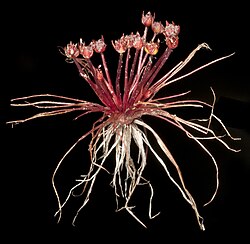Top Qs
Timeline
Chat
Perspective
Trithuria submersa
Species of aquatic plant From Wikipedia, the free encyclopedia
Remove ads
Trithuria submersa is a species of plant in the family Hydatellaceae endemic to the Australian states New South Wales, South Australia, Tasmania, Victoria, and Western Australia.[1]
Remove ads
Description

Vegetative characteristics
It is a 8 cm tall, and 2-5 cm wide,[2] annual herb with glabrous, red, 15–40[3](–50)[4] mm long, and up to 1 mm wide leaves[3] and fibrous roots.[5] Individuals growing submerged in water are slender and green in colour.[2]
Generative characteristics
It is a monoecious species[6] with emergent, bisexual reproductive units ("flowers").[7] The several 2–3 mm wide reproductive units[5] consist of (5–)10–32(–40) mm long stalks,[4] (2–)4–8[8] ovate to lanceolate, 2–4 mm long bracts, 10–20(–35) carpels[5] with 3-6 stigmatic hairs,[9][2] and 2–4 central stamens with 2 mm long red filaments and purple anthers,[5] which are 0.6 mm long.[9] The three-ribbed,[5][9] obovoid, 0.5–0.8 mm long fruit[5] bears sculptured,[8] brown, 0.5 mm long, and 0.3 mm wide seeds.[9] It is a self-pollinating species.[7] Flowering and fruiting occurs from September to January.[10] Seed germination occurs in winter, once the seasonally dry habitat becomes wet.[11]
Remove ads
Cytology
The diploid chromosome count is 2n = 56.[12]
Distribution
It is endemic to the Australian states New South Wales, South Australia, Tasmania, Victoria, and Western Australia.[1]
Taxonomy
It was published by Joseph Dalton Hooker in 1858.[1] The lectotype was collected by R.C. Gunn in Macquarie River, Tasmania, Australia on the 6th of November 1845. It is the type species of its genus.[8] It is placed in Trithuria sect. Trithuria.[13][14]
Etymology
The specific epithet submersa, meaning "underwater", refers to the species aquatic habitat.[9]
Conservation
Under the Threatened Species Protection Act 1995, it is classified as rare.[15]
Ecology
It occurs in temporary pools, at the edge of streams, and seasonal swamps.[6]
References
Wikiwand - on
Seamless Wikipedia browsing. On steroids.
Remove ads


